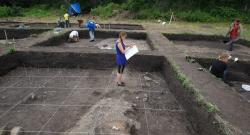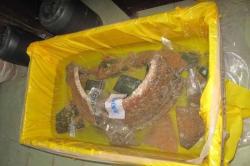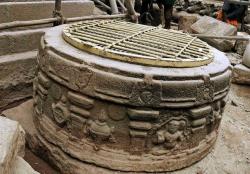INSTITUT SUPERIEUR D'ANTHROPOLOGIE
INSTITUTE OF ANTHROPOLOGY
ONLINE COURSES / COURS A DISTANCE
FALL TERM : OCTOBER 2015
REGISTER NOW
RUSSIE –  Cape Turtle - An ancient fishing settlement dating back over 2,000 years was discovered in the vicinity of Cape Turtle near Vladivostok, according to media reports. The discovery was made by archaeologists from Russia’s Far Eastern Federal University. So far, over 2,500 archaeological artifacts including pottery shards, tools made of stone and bone, ornaments, food residues and the remains of a contraption made of elk horns (possibly an anchor), as well as the remnants of seven dwellings have been discovered at the dig site dubbed "Turtle-7", according to a statement posted on the university’s official website. All of the artifacts will be transported to the university museum for a more detailed study. The current size of the dig site is about 400 square meters, which is about one-third of the settlement’s size. Currently, over 50 archaeologists and university students are working at the site. The university experts believe that the settlement is about 2,000-2,800 years old and belongs to the Jankowski Archaeological Culture.
Cape Turtle - An ancient fishing settlement dating back over 2,000 years was discovered in the vicinity of Cape Turtle near Vladivostok, according to media reports. The discovery was made by archaeologists from Russia’s Far Eastern Federal University. So far, over 2,500 archaeological artifacts including pottery shards, tools made of stone and bone, ornaments, food residues and the remains of a contraption made of elk horns (possibly an anchor), as well as the remnants of seven dwellings have been discovered at the dig site dubbed "Turtle-7", according to a statement posted on the university’s official website. All of the artifacts will be transported to the university museum for a more detailed study. The current size of the dig site is about 400 square meters, which is about one-third of the settlement’s size. Currently, over 50 archaeologists and university students are working at the site. The university experts believe that the settlement is about 2,000-2,800 years old and belongs to the Jankowski Archaeological Culture.
http://sputniknews.com/art_living/20150717/1024739294.html?
ROYAUME UNI – Hackbridge - The dig, in Hackbridge, was commissioned by Sutton Council as a follow-up to an archaeological dig in 1998 on adjacent land to the south of the site at Wandle Meadows, now the Bedzed site, which found evidence of a large-scale, Bronze Age settlement. Several indicators that a small farming community lived there about 4,000 years ago were uncovered. Field boundaries dating to about 2,000BC, indicated by ditches dug to separate fields from each other, and holes for wooden posts, which would have been fence lines, used to tether animals or part of the wooden walls of a house were discovered. No physical artifacts, however, were found dating back to the Bronze Age. Instead, bizarrely an almond Mars bar wrapper, a limited edition version of the popular snack, was found at the centre of the site inside a pit filled with rubble.
http://www.yourlocalguardian.co.uk/news/13421039.Bronze_Age_settlement___and_almond_Mars_bar_wrapper___found_in_archaeological_dig/
KENYA –  Ngomeni - The National Museums of Kenya (NMK) has now concluded that the Ngomeni shipwreck is of Portuguese origin. The ship is approximated to have made its last ill-fated journey in the Indian Ocean waters about 500 years ago, making it the oldest shipwreck in Kenya. Ngomeni is located close to the shore, in shallow water and in a well-protected area in Ras Ngomeni within Kilifi county. Though it sank earlier than Santa Antonio shipwreck in Mombasa, the Ngomeni ship has most of its major components including timbers (frames, ribs and the base) still intact. -“After the excavation the site was backfilled to be left in-situ for better preservation. Underwater objects preserve well under the water in the conditions that they have acclimatised, and also because in those conditions there is very little oxygen.
Ngomeni - The National Museums of Kenya (NMK) has now concluded that the Ngomeni shipwreck is of Portuguese origin. The ship is approximated to have made its last ill-fated journey in the Indian Ocean waters about 500 years ago, making it the oldest shipwreck in Kenya. Ngomeni is located close to the shore, in shallow water and in a well-protected area in Ras Ngomeni within Kilifi county. Though it sank earlier than Santa Antonio shipwreck in Mombasa, the Ngomeni ship has most of its major components including timbers (frames, ribs and the base) still intact. -“After the excavation the site was backfilled to be left in-situ for better preservation. Underwater objects preserve well under the water in the conditions that they have acclimatised, and also because in those conditions there is very little oxygen.
http://www.the-star.co.ke/news/oldest-shipwreck-kenya-finally-identified?
INDE –  Srirangam - The work on clearing the earth all around the wall of a well at Srirangam Sri Ranganathaswamy temple premises has thrown light on exquisite carvings with stone idols all around the compound. The compound of the well, located behind the shrine dedicated to Sri Vibhishna Alwar, got silted up over the years. As part of renovation of the temple, the silt all around the compound of the well was cleared by the temple officials. “The beautiful carvings include the images of Tirumangai Alwar, Nammazhwar, holy chakram and conch,” say the temple authorities. The work was taken up carefully in consultation with senior archaeologists.
Srirangam - The work on clearing the earth all around the wall of a well at Srirangam Sri Ranganathaswamy temple premises has thrown light on exquisite carvings with stone idols all around the compound. The compound of the well, located behind the shrine dedicated to Sri Vibhishna Alwar, got silted up over the years. As part of renovation of the temple, the silt all around the compound of the well was cleared by the temple officials. “The beautiful carvings include the images of Tirumangai Alwar, Nammazhwar, holy chakram and conch,” say the temple authorities. The work was taken up carefully in consultation with senior archaeologists.
http://www.thehindu.com/news/cities/Tiruchirapalli/excavation-reveals-sculptures-on-wall-around-the-well/article7432140.ece?
BULGARIE –  St. Ivan Island - An Early Christian tomb of a senior clergyman, possibly the Father Superior of the monastery, has been discovered by Bulgarian archaeologist Prof. Kazimir Popkonstantinov on the St. Ivan (St. John) Island off the Black Sea coast near the town of Sozopol, where in 2010 he found relics of St. John the Baptist. The newly found tomb is located near the northern part of the altar of the Early Christian basilica on the St. Ivan Island which was part of the St. John the Baptist Monastery. The tomb is dated to the period when the basilica was constructed – the end of the 4th and the beginning of the 5th century AD. At the time, Sozopol and the St. Ivan Island were territory of theEastern Roman Empire known today as Byzantium. The newly found tomb has been opened in the presence of journalists and reporters who were specially invited for the purpose. Unfortunately, it has turned out to be empty – the remains of thesenior Early Christian clergyman who is believed to have been buried there have not been found inside.
St. Ivan Island - An Early Christian tomb of a senior clergyman, possibly the Father Superior of the monastery, has been discovered by Bulgarian archaeologist Prof. Kazimir Popkonstantinov on the St. Ivan (St. John) Island off the Black Sea coast near the town of Sozopol, where in 2010 he found relics of St. John the Baptist. The newly found tomb is located near the northern part of the altar of the Early Christian basilica on the St. Ivan Island which was part of the St. John the Baptist Monastery. The tomb is dated to the period when the basilica was constructed – the end of the 4th and the beginning of the 5th century AD. At the time, Sozopol and the St. Ivan Island were territory of theEastern Roman Empire known today as Byzantium. The newly found tomb has been opened in the presence of journalists and reporters who were specially invited for the purpose. Unfortunately, it has turned out to be empty – the remains of thesenior Early Christian clergyman who is believed to have been buried there have not been found inside.
http://archaeologyinbulgaria.com/2015/07/17/bulgarian-archaeologist-discovers-early-christian-tomb-of-senior-clergyman-on-sozopols-st-john-island-in-black-sea/
USA – Durham - Scanning sonar from a scientific expedition has revealed the remains of a previously unknown shipwreck more than a mile deep off the North Carolina coast. Artifacts on the wreck indicate it might date to the American Revolution. Among the artifacts discovered amid the shipwreck's broken remains are an iron chain, a pile of wooden ship timbers, red bricks (possibly from the ship cook's hearth), glass bottles, an unglazed pottery jug, a metal compass, and another navigational instrument that might be an octant or sextant. The wreck appears to date back to the late 18th or early 19th century, a time when a young United States was expanding its trade with the rest of the world by sea.
http://www.eurekalert.org/pub_releases/2015-07/du-csd071715.php